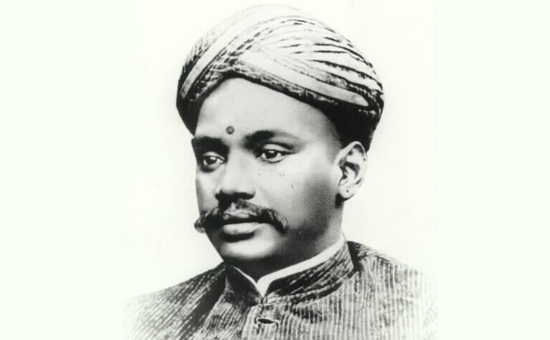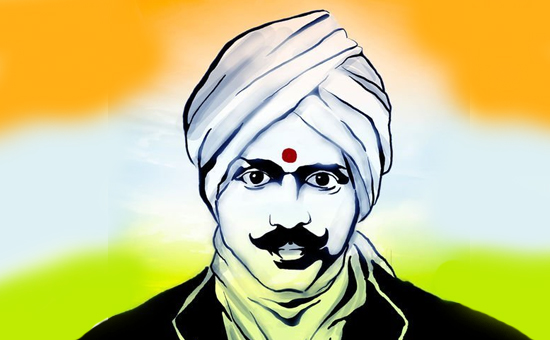- Article tells about the life and fascinating thoughts of Bharati (Mahakavi), Chidambaram and Siva, leading lights of Tamil Nadu’s Independence Movement.
As
Lal-Bal-Pal, the Triumvirates laid the strong foundation of Indian Independence
movement, during the same period, in Tamil Nadu (then Madras Presidency) three
patriots, Chidambaram, Bharati and Siva equally praiseworthy sacrificed their
blood, sweat and all the resources at their command for the liberation of our
Motherland.
Vallinayagan Ulaganathan Chidambaram (September 5, 1872 – November 18, 1936), popularly known by his initials, V.O.C., also known as Kappalottiya Tamizhan ‘Bharatiya Helmsman’, an Indian freedom fighter and founder of Swadeshi Steam Navigation Company in 1906 who competed against the monopoly of the British India Steam Navigation Company (BISNC). He launched the first indigenous Indian shipping service between Tuticorin and Colombo.
 Chidambaram or V.O.C.
Chidambaram or V.O.C.
Subramania Bharathi also known as Bharathi (December 11, 1882 – September 11, 1921), was a Tamil writer, poet, journalist, Indian independence activist, social reformer and polyglot. Popularly known as Mahakavi, he was a pioneer of modern Tamil poetry and is considered one of the greatest Tamil literary figures of all time. His numerous works included fiery songs kindling patriotism during the Indian Independence movement.
 Bharathi – Mahakavi.
Bharathi – Mahakavi.
Subramaniya Siva (October 4, 1884 – July 23, 1925) was a freedom fighter, writer and a journalist. In 1908, he was arrested by the British and was the first political prisoner in Madras jail. While serving a prison term, he was afflicted by leprosy. The British authorities forbade him to travel by rail after his release and hence he was forced to travel on foot. He continued to fight for independence and was incarcerated many times until 1922.
 Siva.
Siva.
Article was first published in Bhavan’s Journal, Mumbai.
Trishakti
One is tempted to compare V O Chidambaram with Ichcha ShaktiGoddess of Wealth, Siva with Kriya Shakthi, Goddess of Power or Valour and Bharati with Gnana Shakti – Goddess of Wisdom. Each of them had many unique attributes and equally many commonalities. Their thirst for freedom
-nationalism stood on the solid bedrock of spirituality.
Spirituality – Swadeshi – Samruddhi
We
can find many evidences of their spiritual orientation from their speeches and
writings. However, we will confine to just one example for each. VOC has
clearly mentioned in his autobiography that he got the seed thought of Swadeshi
from Swami Ramakrishnananda, (founder of Ramakrishna movement in southern parts
of the country) when he met Swamiji at Chennai. In case of Bharati, following
the footsteps of Bankim Chandra, Vivekananda and Aurobindo he perceived Bharat
Mata as one combined form of Trishakti- Durga, Lakshmi and Saraswati.
Subramaniya Siva took it further by endeavouring to build a grand temple for
Bharata Mata in Paappaarapatti, Dharmapuri district, a place where he spent his
final days. Alas, his dream remains yet unfulfilled!
Based
on spiritual principles, all their efforts were not limited to mere political
freedom but goes to economic prosperity and further to liberation of the soul
that is aatma mukti.
A Triveni Sangam
By
comparing Bharati with river Ganga, Chidambaram with river Yamuna and Siva with
river Saraswati, we do not intend to weigh or evaluate their contribution to
the national life.
Mahakavi
Subramania Bharati was a forerunner in many respects. He is aptly a Desiya
(Rashtriya) Kavi, a poet to be understood and appreciated by the entire nation.
He loved, nay worshipped the Akhand Bharat- (chetamilllaata Hindustaanam).
Mahakavi
firmly believed that Bharat will be the Viswa Guru in the future. His conviction
rooted deeply in Sanatana Dharma was that when we, Bharatiyas imbibe the spirit
of Vedas and live by those principles, we could guide the entire world to reach
the immortal state, that is get liberated from the ills sapping the energy of
the individual and the Nation (Viyanulakanaithaiyum
amudhena).
A first-time casual reader may feel that Mahakavi’s ideas were mere exaggerated wishful thinking. Only one who studies Bharati in depth can appreciate that he did not stop with just romanticising his ideas. Many of his poems revealed his grand vision for the future of this nation. He presented a complete road map and suggested feasible means of achieving them through his poems and articles in the journals which had the fortune of availing his services.
Appeals all sections
Bharati
did not leave any aspect of national life untouched. Here is a sample of few of
his splendid writings:
A
song which is said to be meant for children (Paappaa Paattu) through simple words conveys profound concepts
applicable to men and women of all ages. Bharati, in this song, prescribes Desha Bhakti, unflinching faith upon Almighty,
love for fellow beings, care for animals and birds, team building and as the
last line of that poem says it is verily the Art of Living.
He
exhorts the youth of the country to have
Chhatrapati Shivaji, Guru Gobind Singh and Swami Vivekananda as role models.
In his poem titled Pokinra Bhaaratamum
and Varukinra Bhaarathamum, he clearly states
the slave, weak and beaten society should go soon; in its place, a new
generation of youth filled with glow in the eyes, clarity of mind, cheerful
heart and strong shoulders should rise to lead the country to the pinnacles of
glory.
When
he says youth, he gives equal importance to women. Sister Nivedita was his
mentor and he followed her guidelines regarding women liberation. We must bear
it in mind that both of them talked about Maatru Shakti - empowerment of women based on the Bharatiya Samskruti and not
on western models. In yet another song, he reminds that it is the duty of the
menfolk to be chivalrous in
supporting
our mothers and sisters to follow their Dharma.
Comprehensive Road Map
Bharati
believed that independence can be meaningful only when the youngsters have
respect for their forefathers, appreciate their genius and learn from their
lives. To rectify the situation prevailing then, he strongly urges that our
national education should be founded on the Bharatiya values and culture.
To
close with his master piece poem, Wandering
on the snowclad mountain peaks, he provides a comprehensive list of action plans to make our country strong, self-reliant,
and a prosperous country. Starting from clean roads, nurturing both agriculture
and industry, making steel, exploring the space, Ganga Cauvery linking, ship
building, and to taking telecommunication to all the corners of the country
(Kashi to Kanchi).
What
has to be appreciated here is that all of those writings were some 30 years
before Independence, when the glorious era of Lal-Bal-Pal was slowly ending and
Mahatma was yet to occupy the centrestage!
To
read article in PDF format, click on
PDF.
This article was first published in the Bhavan’s Journal, 15 January 2021 issue. This article is courtesy and copyright Bhavan’s Journal, Bharatiya Vidya Bhavan, Mumbai-400007. eSamskriti has obtained permission from Bhavan’s Journal to share.